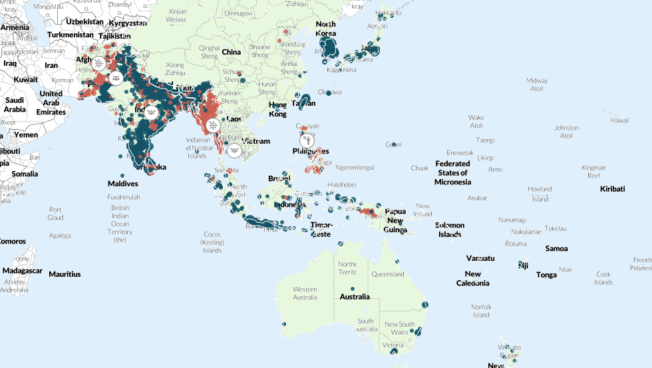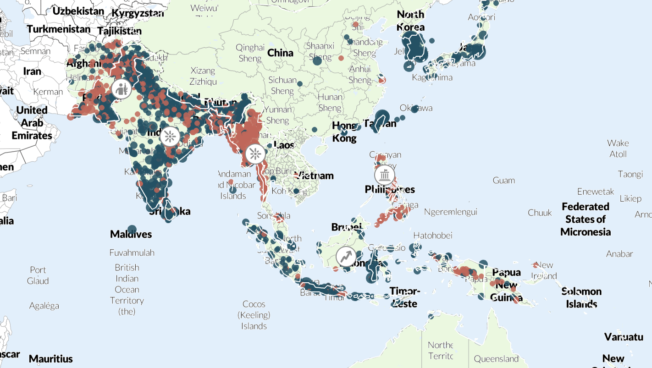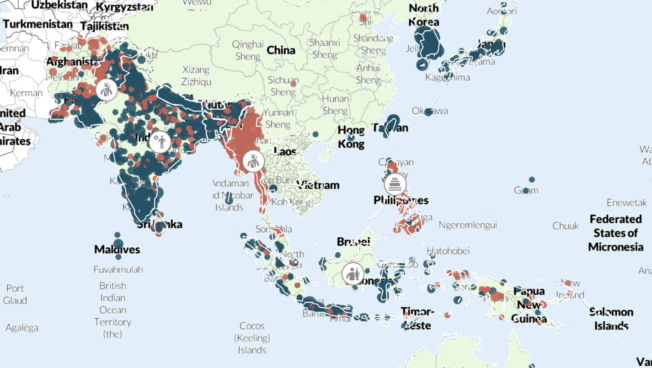Regional Overview
Asia-Pacific
January 2025
Posted: 15 January 2025
In this Regional Overview covering December 2024
- Bangladesh: Anti-Hindu violence sparks regional tensions
- India: Violence targeting civilians increases in the Red Corridor
- Myanmar: The Arakan Army captures Maungdaw and the Western Regional Military Command
- Pakistan/Afghanistan: Security forces step up crackdown on TTP militants
- South China Sea: Philippines and China vessels face off anew after both countries codify their rival territorial claims
- South Korea: Anti-government protests surge following martial law declaration
Bangladesh: Anti-Hindu violence sparks regional tensions
Several incidents of vandalism and looting of Hindu temples and properties took place across at least three divisions in Bangladesh in December. This comes amid a substantial increase in violence against religious minorities across the country since the fall of the secular Awami League government in August 2024. Between 5 August and 31 December, ACLED records more than 120 events of this kind, compared to just eight in the same period prior to former Prime Minister Sheikh Hasina’s resignation. The attacks, in turn, prompted mass protests in neighboring India condemning violence against the Hindu community in Bangladesh. On 2 December, demonstrators stormed the Bangladesh Assistant High Commission in Agartala city, pulling down Bangladesh’s national flag. In rare public comments since being forced out of office, Hasina attacked the interim government for failing to protect Hindus and other religious minorities in Bangladesh.1Indian Express, ‘“‘What is this persecution of minorities for?”: In 1st public address, former PM Sheikh Hasina accuses Muhammad Yunus of genocide in Bangladesh,’ 5 December 2024 The latest violence risks further worsening relations between India and Bangladesh, which have been strained over the former’s perceived support for the Hasina government and Hasina’s continued exile in India.2Mehedi Hasan Marof, ‘“‘Our lives don’t matter”: Bangladeshi Hindus under attack after Hasina exit,’ Al Jazeera, 12 December 2024
India: Violence targeting civilians increases in the Red Corridor
Naxal-Maoist violence targeting civilians more than doubled in December compared to the month prior. ACLED records no less than 11 incidents of violence against civilians in December, the majority of which were carried out by CPI (Maoist) cadres in Chhattisgarh state’s Bijapur district — one of the last remaining strongholds of the rebels in the Red Corridor. While the overall number of events where Naxal-Maoist groups targeted civilians remained at similar levels to 2023, ACLED records more than a 60% increase of these events in Chhattisgarh to more than 70 in total. The militants singled out supporters of the BJP, which is the ruling party at the national and state levels. The spike in violence comes ahead of the local government elections, scheduled for early 2025, which have historically seen increased Naxal-Maoist activity.3Ejaz Kaiser, ‘Chhattisgarh mulls to conduct simultaneous polls of urban bodies, panchayats,’ The New Indian Express, 19 October 2024 It also comes amid security forces’ intensifying crackdown on the militants. Police say they believe the militants are responding to the crackdown by attacking local villagers they accuse of being informants.4Shubhomoy Sikdar, ‘Recent killings in Bastar raise concern amid security gains,’ The Hindu, 12 December 2024
Myanmar: The Arakan Army captures Maungdaw and the Western Regional Military Command
The United League of Arakan/Arakan Army (ULA/AA), the dominant ethnic armed group in Rakhine state, achieved a significant victory in December by taking control of the entire border region with Bangladesh, as well as the Western Regional Military Command (RMC) in Ann township. These milestones mean only three of Rakhine state’s 17 townships are now outside the group’s control. The ULA/AA’s siege of the Border Guard Police Battalion-5 headquarters in Maungdaw township took 55 days and resulted in the capture of approximately 100 military personnel and members of Rohingya armed groups. The loss of Maungdaw was a significant and tactical blow to military morale, sparking criticism from pro-military supporters.5The Irrawaddy, ‘Sportswashing a border disaster; Holding out for heroes in Rakhine; and more’, 14 December 2024 Soon after, the ULA/AA captured Toungup town on 14 December, after soldiers from the local command surrendered. Parallel to this, after nine weeks of fighting, the ULA/AA seized the Western RMC on 20 December, marking the second of Myanmar’s 14 total regional military commands to fall to resistance groups within a span of four months. On 29 December, the ULA/AA also captured Gwa township, which borders Ayeyarwady region. This prompted the military to reinforce locations in Ayeyarwady, fearing further infiltration by the ULA/AA and other resistance groups into the region.
ACLED records at least 98 events in 2024 where the ULA/AA reclaimed territory from the army, including battalion bases and towns. The military’s woes in Rakhine have been mirrored in other parts of the country, with an estimated 287 events of anti-coup forces making territorial gains, nearly five times more than those recorded in 2023. Most of the rebel territorial advances took place in Rakhine and Kachin states. For more, see the report on Myanmar in ACLED’s Conflict Watchlist 2025.
Pakistan/Afghanistan: Security forces step up crackdown on TTP militants
Security forces intensified their crackdown against militants suspected to be affiliated with the Tehreek-i-Taliban Pakistan (TTP) in December, conducting cross-border airstrikes into Afghanistan and counter-insurgency operations in Pakistan’s Balochistan province alongside the more routine operations in TTP’s strongholds in Khyber Pakhtunkhwa. On 24 December, Pakistan launched airstrikes targeting suspected TTP hideouts in Afghanistan’s Paktika province, resulting in dozens of reported civilian fatalities.6Conor Lennon, ‘World News in Brief: Civilian killings in Afghanistan, Kazakhstan air crash, more Syrian refugees return home,’ UN News, 26 December 2024 The airstrikes followed a TTP attack on a Pakistani security camp in South Waziristan district, which reportedly left 16 paramilitary soldiers dead. ACLED records more airstrikes by Pakistan within Afghanistan’s territory in 2024 alone than in all the years since 2018, when ACLED began covering the conflict combined, amid Pakistan’s concerns over the Afghan Taliban government providing a safe haven for the TTP.7Abid Hussain, ‘As Pakistan, Afghanistan attack each other, what’s next for neighbours?,’ Al Jazeera, 30 December 2024 Cross-border tensions continued till the end of the month, as Afghanistan retaliated against the latest airstrikes, with the two countries’ militaries engaging in several clashes along the border.
The military also conducted operations in Balochistan’s Pashtun-dominated areas, where the TTP has historically maintained a strong presence,8Abdul Basit, ‘Questions Surround Pakistani Taliban’s Inroads into Balochistan: Organizational Expansion or Propaganda Stunt?,’ The Jamestown Foundation, 11 July 2023 reportedly leading to the deaths of 24 militants and a soldier across the month. According to ACLED data, reported fatalities from clashes between TTP militants and security forces doubled in December compared to the month prior, with militants accounting for nearly two-thirds of the fatalities. The crackdown comes amid a deteriorating security situation in Pakistan, which witnessed one of its most violent years in over a decade in 2024. For more, see the report on Pakistan in ACLED’s Conflict Watchlist 2025.
South China Sea: Philippines and China vessels face off anew after both countries codify their rival territorial claims
Tensions between the Philippines and China flared up last month over the longstanding territorial dispute in the South China Sea. On 4 December, a China Coast Guard (CCG) ship fired a water cannon against a civilian vessel of the Philippines’ Bureau of Fisheries and Aquatic Resources (BFAR) while the latter was patrolling Panatag Shoal (Scarborough Shoal) with a Philippine Coast Guard (PCG) vessel. The Chinese vessel also sideswiped the BFAR ship and employed other “dangerous” maneuvers against the Philippine vessels, according to a Philippines National Security Council spokesperson, who described the event as a “steep escalation.”9Reuters, ‘Philippines files diplomatic protest against China over South China Sea incident,’ 5 December 2024 The Philippines and China traded condemnations over the latest confrontation, which came about a month after both countries took reciprocal steps to codify their claims over the area. In early November, Beijing defined Chinese territorial baselines around the disputed Panatag Shoal (Scarborough Shoal) after Philippine President Ferdinand Marcos Jr. signed new laws enshrining the country’s maritime claims.10Reuters, ‘China, Philippines spar over new maritime laws, baseline drawings in South China Sea,’ 13 November 2024
Two days after the 4 December confrontation, the Philippines, the United States, and Japan held a joint patrol in the disputed area.11Jim Gomez, ‘US, Japan and Philippine forces jointly patrol in South China Sea after hostilities involving China,’ AP, 6 December 2024 Meanwhile, the Philippines’ new navy chief also said the country could begin to employ its own ‘gray zone’ tactics to counter China’s, referring to more assertive measures that fall below the threshold of armed conflict.12Sam Beltran, ‘Philippines mulls ‘grey zone’ tactics to counter Beijing’s aggression in South China Sea,’ South China Morning Post, 6 December 2024 Against the backdrop of these tensions, the Philippines also continued its push to expand alliances beyond traditional partners, holding its first-ever maritime dialogue with India on 13 December.13Sam Beltran, ‘Philippines and India hold first maritime talks – are territorial rows with China at play?,’ South China Morning Post, 18 December 2024 ACLED records 19 incidents involving confrontations between CCG and the PCG since November 2021, with the latest dangerous maneuvers occurring in August 2024.
South Korea: Anti-government protests surge following martial law declaration
Anti-government protests in South Korea increased in December, following President Yoon Suk Yeol’s declaration of martial law on 3 December. Although martial law was lifted within six hours, protests persisted at elevated levels, with demonstrators calling for the president’s resignation. ACLED records 146 anti-government protest events nationwide between 3 and 7 December, coinciding with an unsuccessful impeachment motion,14The Guardian, ‘Motion to impeach South Korean president fails after vote boycott,’ 7 December 2024 followed by 259 protest events between 8 and 14 December, ahead of a second impeachment motion. On 14 December, the National Assembly passed a bill to impeach Yoon.15AP News, ‘South Korea’s parliament votes to impeach President Yoon Suk Yeol over his martial law order,’ 15 December 2024 While awaiting the Constitutional Court’s decision, anti-government protests have continued unabated.
In response, Yoon defended the legality of his martial law declaration, using it as a rallying point to mobilize his hardline conservative base.16CNA, ‘South Korea’s Yoon vows to “fight to the end”, defying impeachment threat,’ 12 December 2024 Pro-Yoon groups organized protests, opposing the impeachment and supporting martial law. The political climate remained tense when, on 30 December, the Corruption Investigation Office for High-ranking Officials (CIO) requested an arrest warrant for Yoon on charges of insurrection, marking a historic move as the first such warrant against a sitting president in South Korea’s history.17The Chosun Daily, ‘S. Korea court issues arrest warrant for President Yoon over insurrection charges,’ 31 December 2024 Both pro- and anti-government protests are likely to persist as Yoon continues to evade the CIO’s investigation and as South Koreans await the Constitutional Court’s decision on his impeachment.
Correction (16 January 2025): The initial version of this section of the report said that ACLED records 151 anti-government protests between 3 and 7 December, and 269 protest events between 8 and 15 December. It also mistakenly cited 15 December for when the bill to impeach Yoon was passed. It was on 14 December. These numbers and dates were updated to reflect the latest data. Additionally, the initial report said the CIO issued an arrest warrant. The warrant was requested by COI on 30 December and issued by the Seoul Western District Court on 31 December.
See More
See the Codebook and the User Guide for an overview of ACLED’s core methodology. For additional documentation, check the Knowledge Base. Region-specific methodology briefs can be accessed below.
Links:
- Methodology and Coding Decisions for Political Violence and Demonstrations in Afghanistan
- Methodology and Coding Decisions for Political Violence and Demonstrations in China and Taiwan
- Methodology and Coding Decisions for Political Violence and Demonstrations in Myanmar
- Methodology and Coding Decisions for Political Violence and Demonstrations in North Korea







